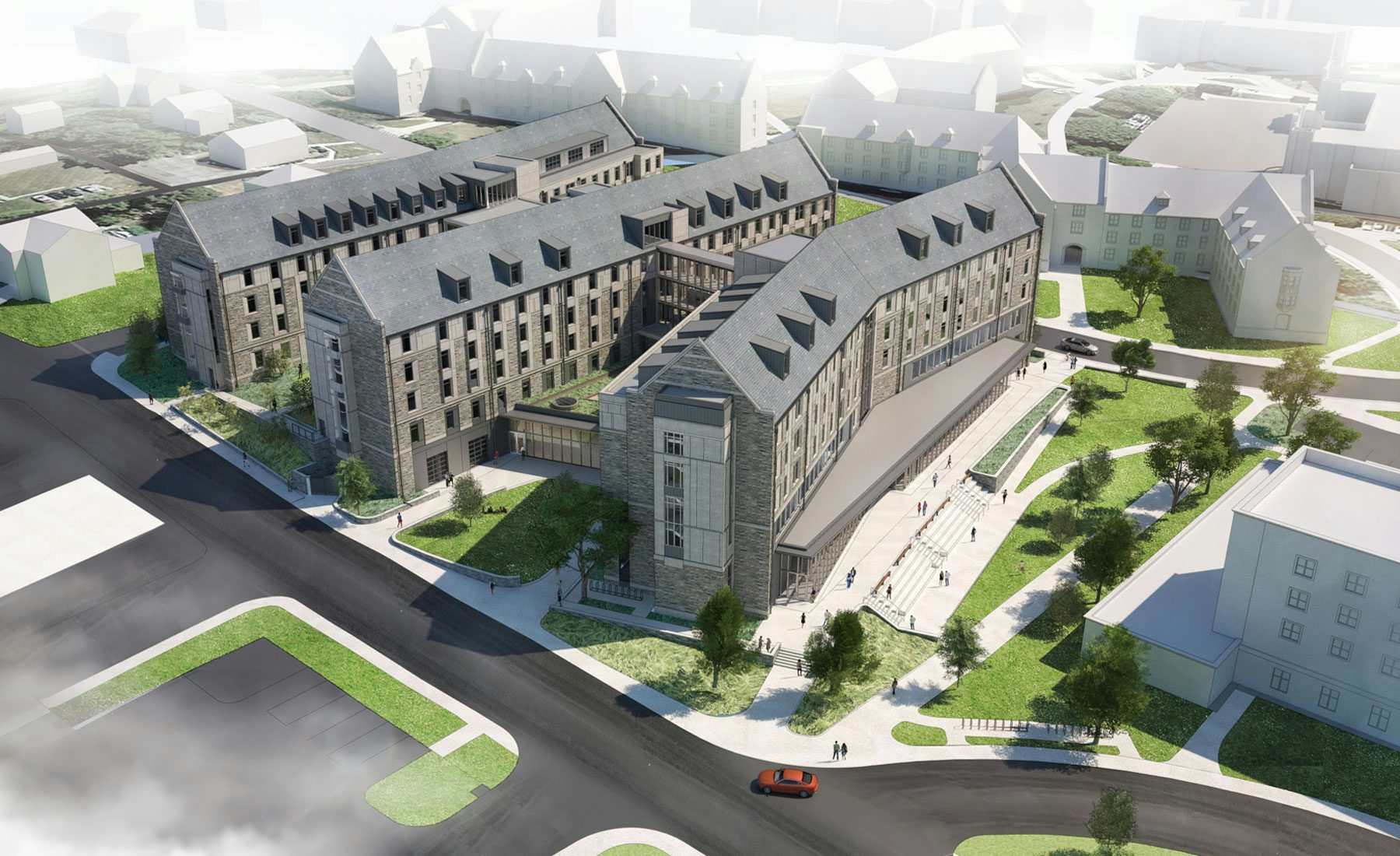Virginia Tech’s Creativity and Innovation District (CID) proposes a transdisciplinary nexus that draws students, faculty, and external partners together from a broad range of disciplines to create a new discourse around the arts and technology. Providing facilities, resources, tools, and technologies that enable this district to thrive, the CID residence hall serves as a cross-cutting living-learning community (LLC) that encourages residents to collaborate in uncommon ways that blur boundaries and disciplines.

How does one start to dismantle barriers to collaboration? In what context is this possible?
Fostering destinations for collaboration. One of 7 districts or “destination areas” identified for development in Virginia Tech's 2047 Beyond Boundaries Master Plan, the CID is envisioned as a “vibrant ecosystem that melds the exploration of innovative technologies and the design of creative experiences with best practices for developing impact-driven outcomes.”
Creating campus collisions. Located at the eastern edge of campus, where Virginia Tech meets downtown Blacksburg, the CID contains arts facilities including the Moss Arts Center, the School of Performing Arts, the School of Visual Arts, and the Institute for Creativity, Arts, and Technology; as well as student life facilities such as the Squires Student Center, Newman Library, and the Graduate Life Center at Donaldson Brown.
Bridging communities, locally and globally. The district’s location near downtown Blacksburg will energize innovation – from idea creation to commercialization – and create a physical space that leverages both creative and entrepreneurial activities. The transformation of this area of campus, starting with the CID LLC, is part of Virginia Tech’s bold strategic vision to move “beyond boundaries” in uncovering innovative solutions that benefit the university as well as the broader region and world.
What exactly does it mean to live and learn “beyond boundaries”?
Developing critical overlaps. For Dr. Ben Knapp, it means transcending disciplinary boundaries through the process of creation and experimentation. As the Founding Director of the Institute for Creativity, Arts, and Technology (ICAT), Dr. Knapp has helped assemble a “living laboratory” of individuals, teams, and communities working towards a common goal of collaborating “without regard for disciplinary limitations.” In pursuit of this mission, the ICAT team has uncovered critical overlaps in the arts, engineering, science, and design fields that are informing how research universities like Virginia Tech can localize creation, innovation, and inspiration in ways that contribute to a broader global learning community.
Making real-world impact. The location of the CID is significant to Dr. Knapp: “Innovation is a process that begins with imagination and creativity and leads to real-world impact. The district will support this work, providing collaborative facilities, tools, and technologies – from virtual environments to maker spaces – to translate ideas into commercial offerings.”
Investing in people and partnerships. By bringing students and faculty together from different corners of campus, while also inviting in collaborators from local and global communities, the CID creates a place for students, faculty, and external partners to advance experimentation involving the arts and technology. Developing partnerships with industry, government, and communities opens up new opportunities for collaboration and funding – all while creating a destination for creative partnerships to flourish and find a physical and intellectual home. The only requirement? A commitment to collaborating across disciplines and departments to share knowledge, solve problems, and contribute innovation.
How does a residence hall serve as a remarkable home and destination for interdisciplinary collaborations?
Providing places to live, learn, and explore. Residence halls are multi-use, 24/7 hubs of activity that provide an ideal environment to integrate social and academic experiences. From fostering student-driven experimental projects to hosting informal social activities, residence halls offer students a sense of belonging through the opportunity to live and learn in a shared community. This sense of shared purpose is key to student success and wellbeing and will serve students long after college and into their careers.
Expressing institutional missions. Living-learning communities (LLCs) organized around themes or topics that matter to an institution offer one way to draw students out of their routines, incite creative collisions, and advance institutional change. In the case of Virginia Tech, LLCs such as the Creativity and Innovation District LLC reinforce district-level strategic planning goals as well as Virginia Tech’s institutional vision for a globally-engaged community that prioritizes experiential learning, applied research, and interdisciplinary partnerships to advance dialogue and problem-solving beyond boundaries.
Creating a signature hub. The Creativity and Innovation District residence hall is intended for students enmeshed in the CID (at the intersection of design, technology, and the visual and performing arts) and designed around two LLCs for the arts and entrepreneurship. The Studio 72 LLC is tailored for students who want to make the arts a pivotal part of their Virginia Tech experience while the Innovate LLC is geared for those who want to gain insight into the entrepreneurial process. A third LLC will also find a home in the building.
Critical to these LLCs and Virginia Tech’s residence life programs are apartments that allow live-in faculty to be fully immersed in the interdisciplinary activity within the district and engage with students in ways that enrich the academic community. Echoing the vibrance of the district, the new CID residence hall will provide a playful, creative, and inspiring environment with a range of indoor and outdoor spaces for the arts, performance, education, demonstration, and research – all rooted in an environment that builds identity and a sense of belonging for residents.
“The whole Creativity and Innovation District is going to become something quite incredible as the design, the architecture, and arts part of campus start to move into this new space,” explains Dr. Knapp. “There really is no precedent across the country that is doing this kind of thing and really merging town, gown, and live-learn community all in this really incredible design involving the arts and innovation space.”

